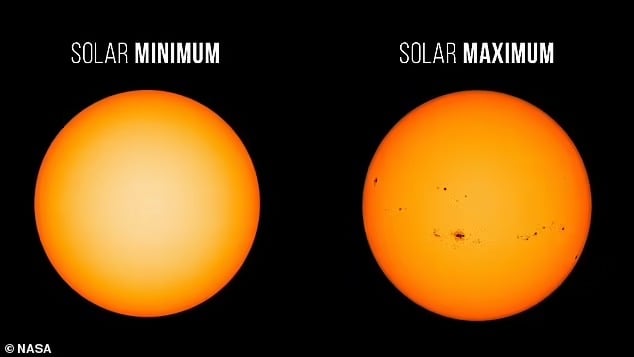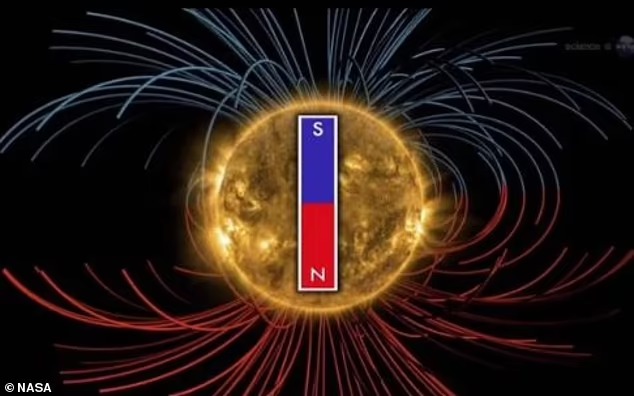NASA warned Solar storms A severe event that could lead to the Internet being cut off from the entire world for weeks, according to the British Daily Mail website. Every 11 years, our sun turns into a chaotic ball that releases a group of huge energy bursts towards the Earth – a period known as “solar maximum”, during which these bursts are The energy is responsible for the northern light displays that have appeared in recent months.
Disrupting the Internet around the world
However, they could also disrupt the Internet and GPS satellites orbiting the Earth – with power outages for weeks. Unfortunately, scientists have confirmed that the solar maximum has officially reached, and this could continue for the next 12 months, according to the British newspaper dailymail.
So, while the chances of seeing… Northern lights The chance of a global internet outage will also increase, and in a conference call, NASA, the National Oceanic and Atmospheric Administration and the Solar Cycle Prediction Commission confirmed that the Sun has reached its maximum period, which may last for next year.

storm
Solar activity
“During the period of maximum solar activity, the number of sunspots, and therefore the amount of solar activity, increases,” said Jamie Favors, director of NASA’s Space Weather Program. “This increase in activity provides an exciting opportunity to learn about our closest star, but it also causes real effects on Earth and in the sky.” Throughout our solar system.
However, the date of peak solar activity on the Sun during this maximum is not yet known, and Mr. Talaat, director of space weather operations at the National Oceanic and Atmospheric Administration, added: “While the Sun has reached its maximum period for solar activity“The month in which solar activity peaks on the Sun will not be determined until months or years later.”
It’s not just the essential light and warmth that Earth receives from the Sun, which is on average 93 million miles away. Our star is a huge ball of hot, electrically charged gas that moves, generating a strong magnetic field, formally known as a dipole field.
This dipole field – which extends from one pole of the Sun to the other just like the Earth – goes through a cycle called the solar cycle, and every 11 years or so, the Sun’s magnetic field completely flips, meaning the north and south poles swap places.

Solar storm
At the beginning of the solar cycle (just after the solstice), the Sun’s surface has the fewest black spots on its surface, known as “sunspots,” as the middle of the solar cycle is the maximum for solar activity, when the Sun has the greatest number of sunspots.
During this maximum for solar activityThe most intense space weather, known as solar storms, is expected. Fortunately, solar storms are not dangerous to humans. However, they can affect satellites in orbit as well as power grids on Earth.
“These solar storms are more likely to occur when the number of sunspots is high,” Dr Dibyendu Nandy, a physicist from the Center of Excellence in Space Science at the Institute of Scientific and Technological Research in Kolkata, India, told Mail Online.
“More severe storms can sometimes lead to catastrophic orbital degradation of low-Earth orbit satellites and disrupt satellite-based services such as communications and navigation networks, and they can also cause strong disruptions to electrical power grids that are down in areas with power lines.” The high width is due to the Earth’s magnetic field.
“Of course, they also create beautiful aurorae, so we can expect 2024 to be a good year for aurora hunters.”
A 2021 study published by a scientist at the University of California, Irvine found that the Internet could be down for weeks in the wake of a severe solar storm, due to vulnerabilities in the world’s massive network of submarine communications cables.
The electromagnetic fluctuations caused by Solar storms The severe ones cannot directly damage the fiber optic cables that form the backbone of the Internet, however, they do have the potential to take out signal boosters spread along submarine cables that are necessary to maintain communications over large distances.
The study predicted that the probability of a solar storm capable of causing catastrophic disturbances in the next ten years ranges between 1.6 and 12 percent. In 1859, a huge solar storm known as the Carrington Event sent a powerful solar ejection toward Earth, disrupting communications on Earth. If such an event were to occur in today’s world, the effects on our communications systems would be catastrophic.
Fewer storms struck in 1921 and 1989 – the latter of which disrupted the power grid run by Hydro-Quebec, causing a nine-hour blackout in northeastern Canada. Scientists will not be able to determine the exact peak of this solar maximum for several months because They can only be determined after tracking a steady decline in solar activity after that peak.
However, scientists have determined that the last two years on the Sun were part of this active phase of the solar cycle, due to the constantly high number of sunspots during this period, and scientists expect the maximum phase to continue for another year or so before it enters the Sun.
